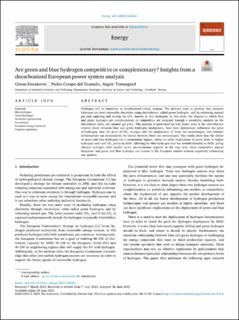| dc.contributor.author | Durakovic, Goran | |
| dc.contributor.author | Crespo del Granado, Pedro Andres | |
| dc.contributor.author | Tomasgard, Asgeir | |
| dc.date.accessioned | 2023-08-24T12:30:52Z | |
| dc.date.available | 2023-08-24T12:30:52Z | |
| dc.date.created | 2023-07-26T20:54:28Z | |
| dc.date.issued | 2023 | |
| dc.identifier.issn | 0360-5442 | |
| dc.identifier.uri | https://hdl.handle.net/11250/3085662 | |
| dc.description.abstract | Hydrogen will be important in decarbonized energy systems. The primary ways to produce low emission hydrogen are from renewable electricity using electrolyzers, called green hydrogen, and by reforming natural gas and capturing and storing the CO, known as blue hydrogen. In this study, the degrees to which blue and green hydrogen are complementary or competitive are analyzed through a sensitivity analysis on the electrolyzer costs, and natural gas price. This analysis is performed on four bases: what is the cost-effective relative share between blue and green hydrogen deployment, how their deployment influences the price of hydrogen, how the price of CO changes with the deployment of these two technologies, and whether infrastructure can economically be shared between these two technologies. The results show that the choice of green and blue hydrogen has a tremendous impact, where an early deployment of green leads to higher hydrogen costs and CO prices in 2030. Allowing for blue hydrogen thus has notable benefits in 2030, giving cheaper hydrogen with smaller wider socioeconomic impacts. In the long term, these competitive aspects disappear, and green and blue hydrogen can coexist in the European market without negatively influencing one another. | en_US |
| dc.language.iso | eng | en_US |
| dc.publisher | Elsevier | en_US |
| dc.rights | Navngivelse 4.0 Internasjonal | * |
| dc.rights.uri | http://creativecommons.org/licenses/by/4.0/deed.no | * |
| dc.subject | Matematisk optimering | en_US |
| dc.subject | Mathematical optimization | en_US |
| dc.subject | Bærekraftige energisystemer | en_US |
| dc.subject | Sustainable energy systems | en_US |
| dc.subject | Naturgass | en_US |
| dc.subject | Natural gas | en_US |
| dc.subject | Hydrogen | en_US |
| dc.subject | Hydrogen | en_US |
| dc.subject | Naturgasskonvertering | en_US |
| dc.subject | Natural gas conversion | en_US |
| dc.title | Are green and blue hydrogen competitive or complementary? Insights from a decarbonized European power system analysis | en_US |
| dc.title.alternative | Are green and blue hydrogen competitive or complementary? Insights from a decarbonized European power system analysis | en_US |
| dc.type | Peer reviewed | en_US |
| dc.type | Journal article | en_US |
| dc.description.version | publishedVersion | en_US |
| dc.subject.nsi | VDP::Samfunnsøkonomi: 212 | en_US |
| dc.subject.nsi | VDP::Economics: 212 | en_US |
| dc.source.volume | 282 | en_US |
| dc.source.journal | Energy | en_US |
| dc.identifier.doi | 10.1016/j.energy.2023.128282 | |
| dc.identifier.cristin | 2163727 | |
| dc.relation.project | Norges forskningsråd: 308811 | en_US |
| cristin.ispublished | true | |
| cristin.fulltext | original | |
| cristin.qualitycode | 2 | |

